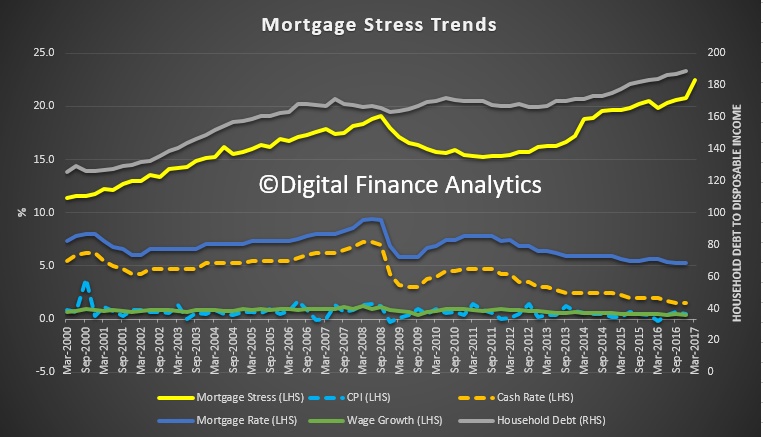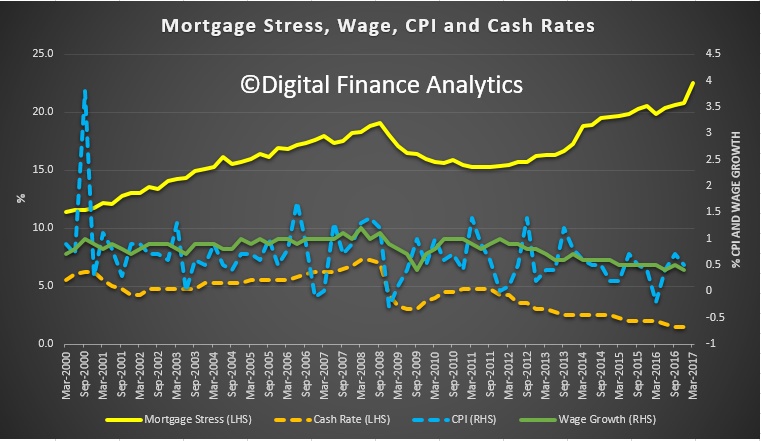We updated our mortgage stress models recently, which showed that around 669,000 households are in stress, which represents 21.8% of borrowing households. Those results are a point in time view of households finances. The RBA also said that one third of households have no mortgage buffer.
Today we take a longer term view of the rise of mortgage stress, which is driven by a combination of larger mortgages, flat incomes, higher living costs and rising debt.
The first chart tracks household debt to disposable income from the RBA, as well as mortgage rates, the cash rate and both CPI and wage growth.
Stress levels rose consistently through the early 2000’s as debt and mortgage rates rose, to reach a peak of 19%, when the cash rate was 7.25%, the average variable mortgage rate was 9.35% and the household debt to disposable income sat at around 170. Those with a long memory may remember that we were warning about this trend in the 2000’s.
But then the GFC hit, rates were cut, and mortgages rates fell sharply to 5.8%. However the debt to disposable income ratio only fell a little to 168.
Lower rates stoked demand for property, so prices started to rise, and mortgage rates moved higher, then lower as the RBA used housing to try to fill the gap left by the mining sector moving into the production phases. Household debt to disposable income has since moved higher to a new high of 189 and is still rising.
During more recent times, mortgage stress and household debt has been moving up – and the latest stress data shows an acceleration as income growth all but stalls, and costs of living keep going, mortgage rates are rising.
 To look at this in more detail, here is the same data, but with CPI and wage growth now mapped to stress and the cash rate. The fall in wage growth is significant, and this has now become one of the main drivers of stress.
To look at this in more detail, here is the same data, but with CPI and wage growth now mapped to stress and the cash rate. The fall in wage growth is significant, and this has now become one of the main drivers of stress.
 My point is, nothing has suddenly changed. The inexorable rise in household debt, especially in a low wage growth scenario was obviously going to lead to issues (see our posts from 3 years back!) and so the RBA’s apparent volte-face is a welcome paradigm shift, but late to the party. Perhaps the New Governor had a different perspective from the previous incumbant!
My point is, nothing has suddenly changed. The inexorable rise in household debt, especially in a low wage growth scenario was obviously going to lead to issues (see our posts from 3 years back!) and so the RBA’s apparent volte-face is a welcome paradigm shift, but late to the party. Perhaps the New Governor had a different perspective from the previous incumbant!
Of course the question now is, can this be managed without a property correction? Probably not. Read our definitive guide to mortgage stress here.
One final point. In the recent Financial Stability report, the RBA used HILDA data to argue that household financial stress was not too bad. But the data is not that recent, latest from 2014 and 2015, and since then our surveys highlight that some more affluent households are also being squeezed, especially as mortgage rates rise, and their incomes stall; they are highly leveraged.
The HILDA Survey also includes questions on financial stress experienced by households over the previous year. There was a broad-based decline in the share of households experiencing episodes of financial stress between 2001 and 2015 (the time span available in the HILDA Survey). Nonetheless, households that were highly indebted in a particular year had a greater
propensity to experience financial stress. For instance, households that were highly indebted in 2002 were more likely to experience at least one incidence of financial stress in all other years compared with households that were less indebted in 2002 (Graph C5, right panel). The result also holds true for other cohorts. This suggests that a greater share of highly indebted households face financial difficulties and are more likely to be vulnerable to events that affect their ability to repay their debt, such as income declines or increases in interest rates.Overall, these data highlight that highly indebted households can be more vulnerable to negative economic shocks and pose risks to financial stability. In particular, highly indebted households are less likely to be ahead of schedule on their mortgage repayments and they are more likely to experience financial stress, hence could be more vulnerable to adverse macroeconomic shocks. The consequent effects of this stress on the broader economy may be exacerbated by the disproportionately large share of investor housing debt owed by highly indebted households. Hightened investor demand can contribute to the amplification of the cycles in borrowing and housing prices, particularly when this investment is highly leveraged. Nonetheless, HILDA data also show that much of the debt held by highly indebted households is owed by households with high income and wealth, who are typically better placed to service larger amounts of debt.

2 thoughts on “Tracing The Rise Of Mortgage Stress”